Introduction
As the pioneer of e-commerce, IBM proposed the Electronic Commerce (e-commerce) concept in 1996. By the end of the 1990s, e-commerce was defined as ″any form of business transaction in which the parties interact electronically rather than by physical exchanges or direct physical contact″ European Commission(1998). With the development of information technology, the combination of Internet and e-commerce becomes increasing closely, e-commerce plays in a variety of new forms such as Business to Business (B2B), Business to Consumer(B2C), Consumer to Consumer(C2C), or online to offline (O2O) to impact the traditional business model. Bricks-and-mortar companies realize the importance of online and offline business. It will inject new vitality to the traditional industry.
Shipping industry is a traditional industry. Traditional industry is a relative concept, there is not an authoritative definition of it. According to
Wang(1999), traditional industries relative to the emerging industries such as information industry, including steel industry, coal industry, automobile industry and shipping industry etc. We may through the information technology to traditional ways and so on industry transformation, seepage and substitution, the promotion traditional industry development. Although shipping industry′s informationization works well inside, the information asymmetry is mainly shown in customers and shipping companies. Industrial chain upstream and downstream information sharing is backward. After the hundreds of years development, starting with the shipping market segment, there are more than twenty types of jobs in the shipping industry such as shipping company, shipper, consignee, shipping agent, freight forwarder, commodity inspection and customs etc. If we want to establish a new platform to integrate the whole industries with so many jobs, that will be a long process.
Traditional shipping service mainly relies on telephone, fax and email to booking and delivery the documents artificially, that will lead to a complicated circle, high error rate and low efficiency. This traditional kind of organization mode and service ability is out of date. It can be said that the external demand pushed the shipping industry to get better use of the Internet, including changing its business model to provide better service for its customers. The combination of shipping industry and electronics information industry forms one of the most promising new industries - shipping electronics industry.
Today, the world is entering the big data era, information economy is gradually made to take place of industrial economic and impel social development. Shipping industry is facing the big challenge to connect with e-commerce smoothly.
The purpose of this paper is to point out the potential risk of establishing and operating the e-commerce shipping platform and to provide a suggested model of the shipping e-commerce shipping platform in China.
Theoretical background
2.1 Overview of the e-commerce classification
E-commerce is a new form of business using Internet as the platform to carry out commercial activities. E-commerce is deemed to as one of several marketing channels, including the use of the Internet to support inter-organizational processes, such as marketing, ordering and related service activities
Aldin and Stahre(2003).
B2B e-business is developed mainly rounding the e-commerce platform. E-commerce platform has four stages, such as information, negotiation, transaction and after the event. The purpose of build e-commerce platform is in order to obtain a certain market opportunities or integrate some kind of resources, so every form of e-commerce platform are differ in the target user, ways to create value, service management and function design.
According to the buying behavior, the classification of the buyers and market concentration, Brratt and Rosdhal (2002) has carried on the simple classification of electronic market, but not analysis of the value that each e-market can provide.
Berryman(1998) pointed out that according to the e-market control right the e-market can be divided into three types, the seller′s control type, the buyer′s control type and the independent third party type.
Ordanini and Pol(2001), Skojott‚ÄĒLarsen(2003) analysis of the e-commerce platform on the following four aspects as shown in Table
1. Vertical e-commerce platform can provide the professional service of some certain industrial market such as shipping industry, steel industry, chemical industry and so on. Horizontal e-commerce platform is a cross-industry, which can make the function of process automation.
Table 1
Classification of e-commerce platform
|
1 |
horizontal and vertical e-commerce platform |
|
2 |
the seller, the buyer and the neuter e-commerce platform |
|
3 |
static and dynamic mechanism e-commerce platform |
|
4 |
open and closed e-commerce platform |
The function of transportation is to transport the cargo from A to B, so the container transportation quantity is determined by the sellers and buyers, it is not to be controlled by the platform with the help of internet. The value of the e-commerce platform is just the value of the services which will let the service do better. So how to connect the e-commerce with the shipping industry is the new problem and a big challenge to the whole industry. To a specified shipping company, that will help the company to have the competitive edge in the whole shipping market if it can use the e-commerce in its business.
2.2 Overview of existing e-commerce shipping platform
In the late 1990s, shipping companies was facing a situation that the top 2000 shippers unite together to pressure them to provide higher quality data information, and the shipping companies also worry that the new integrated information agent will preempt the limited market resources, so several large shipping companies decided to set up their own portal.
2.2.1 Main public information platforms of the global shipping industry
In the global shipping industry there are main three public platforms -INTTRA, GT Nexus, and Cargo Smart. These three main platforms have covered the majority of the ocean transportation.
INTTRA is the world’s largest, e-commerce network for the ocean shipping industry. More than 22% of global ocean container trade was through the INTTRA platform each week. It provides several shipment managements such as Ocean Schedules, Cargo Insurance, Container Booking, Shipping Instructions, Shipping Order, Bill of Lading, Container Tracking and e-Invoicing.
GT Nexus is the developer and operator of the largest cloud supply chain platform in the world. It provides the cloud-based collaboration platform that every sector relies on to automate hundreds of supply chain processes on a global scale, across entire trade communities.
CargoSmart Limited Launched in 2000, it provides global shipment management software (solutions) to help shippers, consignees, ocean carriers to improve planning and provide on-time services. It leverages big data sources and a cloud-based platform to offer award-winning sailing schedules, visibility, documentation, contract management, compliance, and benchmarking solutions.
INTTRA, GT Nexus and CargoSmart are suitable for big shipping companies. In China there are many medium and small shipping companies. These three world′s biggest e-commerce shipping platform are too big for them. They need some comprehensive and small systems for them.
2.2.2 Main existing e-commerce shipping platform in China
As shown in Table
2, Chinese shipping E-commerce platform models are divided into shipping companies‚Äô own private platform and public platform owned by the third party. On 11th July 2014, CSCL announced it will cooperate with Alibaba to establish a global e-commerce integrated logistics and information service platform which is called ‚Äėe-shipping‚Äô. This breaking news leads to a new form that is the one-stop logistics service platform.
Table 2
Main existing e-commerce shipping platform in China
|
Platform name |
Establishe d time (Year) |
Type of platform |
|
Shipping online |
2000 |
public information platform |
|
Shipping China |
2002 |
comprehensive platform |
|
Jctrans |
2003 |
global freight forwarders |
|
SSEFC |
2010 |
public shipping capacity trading platform |
|
Epanasia |
2012 |
shipping company’s own private platform |
|
NingBo shipping e-booking |
2012 |
public online and offline platform |
|
Sinotransbooking |
2013 |
Shipping company’s own private platform |
|
E-shipping |
2014 |
one-stop logistics service platform |
|
E-global |
2014 |
cross-border e-commerce platform |
In China, the first stage of the existing e-commerce shipping platform was established by the third party served for the freight forwarders which need a platform to get the information of cargos and ships. This stage of e-commerce shipping platform is just an online platform for the purpose of information transaction not considering about the back-end transaction service(Table
3).The second stage of the e-commerce shipping platform was built up by shipping companies. In this stage, the shipping companies develop its own service products, transforming its traditional services to the internet. The main business of this kind of shipping platform is concentrating on the online and offline service. Through the platform, all transactions have their records for check. CSCL has started a new form of e-commerce shipping platform. With the help of Alibaba, this platform is established for the global, specializing in containerized international logistics and transportation (Table
3).
Table 3
Main business of existing e-commerce shipping platform
|
Platform name |
Main business |
|
Shipping online |
information of shipbuilding |
|
information of ship sale and purchase |
|
shipping schedule information inquiry and service |
|
cargo booking inquiry service |
|
SHIPPING China |
shipping mart |
|
WIFFA transactions platform payment platform |
|
Jctrans |
sea freight rate inquiry freight forwarder partnership inquiry |
|
logistics news report |
|
logistics big data service |
|
information of trade big data service |
|
SSEFC |
international dry bulk cargo capacity trading service |
|
China costal bulk(coal) capacity trading service |
|
Shanghai containerized capacity service |
|
Epanasia |
domestic and international information inquiry and service |
|
trucking service |
|
marine insurance |
|
cargo booking |
|
Ningbo shipping e-booking |
freight inquiry |
|
transaction center |
|
information inquiry and service |
|
e-booking |
|
payment center |
|
Sinotransbooking |
Shipping news report freight inquiry |
|
information inquiry and service |
|
e-booking |
|
E-shbpping |
on-line booking service on-line booking confirm service |
|
on-line check against bill of lading service |
|
customs service |
|
tracking service |
|
on-line payment |
|
E-global |
cross-border e-commerce logistics service |
|
integrated logistics services |
Data collection and analysis
The purpose to obtain efficient data is to analyze what item functions and informations does consignees want to use through the e-commerce shipping platform. Based on the analysis of the data collected by the random searching, the data of e-commerce shipping’s main business is analyzed. Furthermore, how to choose a specific e -commerce shipping platform is analyzed. Based on analyzing the data collected some important results are concluded.
3.1 Data collection
Data was collected through China shipping data, Chinese port data, 210 samples of the questionnaire named ‚ÄėEcommerce shipping platform survey‚Äô which is designed by the author. As an anonymous questionnaire survey conducted via internet, this survey covers 210 target populations from the staffs of shipping companies, freight forwarders, trading company and related companies(Table
4). In general speaking, at least 150 copies of questionnaire are needed in a market survey. The author designs a questionnaire survey using simple language and makes each question as short as possible, the author ensured all the questions serve the object survey eventually. We had authorized the biggest inquiry website named ‚ÄėSOJUMP‚Äô to help us to complete it. In all, 210 copies were received. The authorized inquire website chose these respondents randomly.
Table 4
The subject of investigation
|
Category |
Numbers of investigated people |
|
freight forwarders |
29 |
|
shipping company |
162 |
|
trading company |
16 |
|
related companies |
3 |
|
Total |
210 |
3.2 Data analysis
3.2.1 The data for situation of shipping industry of China
As shown in Table
5, the container throughput was rapidly declined in 2009 because of the financial crisis of 2008, but the trend of global container shipping volume is increasing of last ten years. Chinese ports continue to take the lead in the growth rate of the handling capacity of the container throughput. The data shows that in 2014, 8 out of the Top10 ports come from China. The top 10 port achieves growth in 2014(Table
6).
Table 5
Global container shipping volume
|
Year |
container throughput (Million TEU) |
YoY |
|
2014 |
170.86 |
4.82 |
|
2013 |
163 |
5.16 |
|
2012 |
155 |
2.65 |
|
2011 |
151 |
7.09 |
|
2010 |
141 |
12.8 |
|
2009 |
125 |
-8.76 |
|
2008 |
137 |
4.58 |
|
2007 |
131 |
11.97 |
|
2006 |
117 |
10.38 |
|
2005 |
106 |
10.42 |
Table 6
Container throughput at global top10 ports in 2014
|
2014 |
Port |
Country |
Container Throughput (10 thousand TEU) |
|
1 |
Shanghai |
China |
3528.40 |
|
2 |
Singapore |
Singapor e |
3390.00 |
|
3 |
Shenzhen |
China |
2403.00 |
|
4 |
Hong Kong |
China |
2228.00 |
|
5 |
Ningbo-Zhoushan |
China |
1945.00 |
|
6 |
Busan |
Korea |
1842.00 |
|
7 |
Qingdao |
China |
1662.44 |
|
8 |
Guangzhou |
China |
1616.00 |
|
9 |
Dubai |
Emirates |
1525.00 |
|
10 |
Tianjin |
China |
1405.00 |
According to the analysis of global container shipping volume and container throughput at global top10 ports in 2014, the ports in China have formed nearly 90% of global container throughput. Under the circumstance of the risk for a potential economic downturn still exists, the situation of shipping industry of China is still prosperity. These means shipping companies will operate their main voyage around China which will lead more and more efficient and accurate services such as shipping schedule inquiry, freight rate inquiry, marine insurance and so on. So the need of establishing more e-commerce integrated service platform is quite urgent.
3.2.2 The data for expected functions of an e-commerce shipping platform
In the shipping industry, there are so many business links between shipping company, freight forwarder and shipper. The freight forwarder can make money from the shipping company and the shipper because of its specific knowledge and information asymmetry. How to maximize the interest of the shippers? Shippers can use e-commerce platform to do some on-line works such like on-line booking and on-line payment by itself will reduce some agent cost.
As shown in Table
7, excepted the function of on-line payment, the other functions are all exceed 50%. That means that most companies are worried about the internet security and the credit of the contractor. This is a big problem which impedes the development of the e-commerce platform. There also remains a potential risk of trust fraud. Y.
Zhang and J. Bian (2013) thought that the e-commerce in China is facing with many challenges, among which the trust fraud problem is the biggest issue. How can we solve the problem? The further analysis in this paper answers these questions.
Table 7
Expected functions of an e-commerce shipping platform
|
Category |
Number of selected items |
Proportion (%) |
|
on-line booking |
163 |
77.62 |
|
shipping schedule inquiry |
145 |
69.05 |
|
ship′s location inquiry |
138 |
65.71 |
|
arrival notice of cargo |
157 |
74.76 |
|
document operating |
112 |
53.33 |
|
cargo inquiry |
161 |
76.67 |
|
freight rate inquiry |
152 |
72.38 |
|
client service |
117 |
55.71 |
|
on-line payment |
100 |
47.62 |
|
Total |
210 |
|
In our 210 valid questionnaires, the most appreciated function is on-line booking, 163 people chose this item. This means that the shippers and freight forwarders need a convenient and efficient way to do the business. In traditional, people use e-mail and fax to do booking, but probably bring some mistakes and waste time.
Arrival notice of cargo and cargo inquiry are behind the on-line booking to be chosen. Shipping market is very complex because it includes a lot of kinds of cargos. No one can know all the information of all cargos. So people need a public information platform to issue the freight rate for container cargos, bulk cargos and dangerous cargos etc. E-commerce shipping platform has a big database, which can easily help the related contractors to find their interested information.
3.2.3 The data for how to choose an appropriate e-commerce shipping platform
From the overview of the existing e-commerce shipping platform in China, there are more than 10 main shipping platforms for the users to choose. Why some freight forwarders chose public information platforms but some shipping companies liked to establish their own platform by themselves or cooperate with internet companies to operate the platform together?
In this big data era, transaction is the king of the international trade and transportation. B. R.
Holmstrom and J. Tirole(1989) thought to the specific industrial organization the prime source of transaction costs is information. For technological reasons it needs the company to become specialization in some field.
For the freight forwarders, their main profit is on the one hand they get commissions from the service of the shippers and consignees, on the other hand from the discount of the freight rate. For this reason, they do not need to establish the e-commerce platform by themselves. They only want an e-commerce platform includes all the information they can get rapidly and correctly. They will choose the platform concentrated on data updating. As shown in Table
8, data updating is the most selective factor to be chose of our investigated.
Table 8
Selected factors of an e-commerce shipping platform
|
Category |
Number of selected items |
Proportion (%) |
|
Data updating |
168 |
80 |
|
Information service level |
158 |
75.24 |
|
Customer management system |
159 |
75.71 |
|
Customer′s satisfaction |
119 |
56.67 |
|
Platform awareness |
77 |
36.67 |
|
Comprehensive strength of platform |
112 |
53.33 |
|
Viscosity of the platform |
100 |
47.62 |
|
Total |
210 |
|
For the shipping companies, in the circumstance of lower freight rate and high competitive market, the best way to get more profit is to improve their service level. In the e-commerce era, an attractive shipping platform will help them to get the target. So the shipping companies, pay their attention to establish the platform by themselves. Through the platform, the company’s mainly information including data updating, service level, client management and customer’s satisfaction are vividly displayed.
Comprehensive strength of the e-commerce shipping platform and awareness of the e-commerce shipping platform is more and more important in the next competitive market. Brand awareness and viscosity of the platform will attract new clients to browse the website and choose to deal with the company. For instance, on 12th Nov 2014, COSCO announced that it will cooperate with Alibaba to build cross-border E-commerce logistics service. It offers whole journey logistics service for cargos of Tmall inbound from Guangzhou ports. Why did COSCO not only establish its own shipping platform which is named Epanasia but also cooperate with Alibaba? Because Alibaba is the top e-commerce platform in China, the brand awareness of Alibaba and the plenty client source of Tmall will help COSCO to be the integrated logistics company and the leader of the cross-border e-commerce service market. In this information era, the company who can keep pace with e-commerce will laugh last.
Potential risk of the e-commerce shipping platform
E-commerce shipping platform have features of heavy investment and high risks. In China, e-commerce shipping platform is still in the initial stage, there remain some risks to be the obstacle of its development. So it is necessary to eliminate these potential risks and plan related strategies.
4.1 Risk of information asymmetry
In terms of contract theory, information asymmetry in transactions means that one party has more or better information than the other, which creates an imbalance of power in transactions. In the shipping market, there remains the principal-agent problem between shipping companies and consignees. For instance, once a domestic shipper wants to transport his goods to Seattle by sea, but he is a new client and not familiar with the information of sea freight rate, customs clearance procedure, marine insurance etc. He entrusts a freight forwarder to process the transportation. In traditional, the authorize freight forwarder has relevant information whereas the shipper does not have.
E-commerce platform has the advantage of resource sharing and data highly transparent, particularly in terms of price, the special promotions, a big discount can bring tangible benefits to end-users. In practice, however, shipping companies announced through different channels with different price to different consignees.
Though the e-commerce platform every participant can conveniently obtain the required information. However, freight forwarders may want to keep some relevant information as trade secret, rather than sharing with shippers. Information asymmetry will no doubt affect the credibility of e-commerce shipping platform. On the one hand is the trend to information transparency to all client, on the other hand shipping companies may protect freight forwarder’s legal interest. So how to solve this conflict is worth discussing. We suggest that bring in incentive system to the freight forwarder, the more records of e-booking from the platform the lower freight rate it will have.
4.2 Risk of trust fraud
Trust plays an important role in governing trading. Lack of trust is a big problem of e-commerce. There are three types of trust: deterrence-based , knowledge-based, and identification-based. The highest level of trust allows one party to act as an agent for the other and substitute for that person in interpersonal transactions. Trust exists because the parties understand each other′s intentions and appreciate the other′s wants and desires. (
Lander, Purvis, McCray, & Leigh, 2004).
China’s e-commerce market faces many challenges, among which the trust fraud problem is the biggest issue (
Y. Zhang and J.Bian 2013). In the payment of L/C, if the shipper could not get original B/L before the expiration of L/C he cannot negotiate from the negotiating bank. In order to negotiate from the negotiating bank, Anti-dated B/L, Advanced B/L has appeared. The legal consequence of Anti-dated B/L, Advanced B/L is one kind of trust fraud.
The operator of the e-commerce shipping platform must establish a complete credit data and credit evaluation system to solve the problem. Credit evaluation must be based on objective information and data, government departments should establish the basic principles of sincerity. By establishing comprehensive database as shown in Table 15, all clients can have a clearer understanding each other, increasing the transparency of transactions. For instance, when a shipper wants to issue Advance B/L or any other illegal documents, give him a punish record and share it as a public information to the all clients.
4.3 Payment risk
There exist many security problems in current e-commerce payment system, which severely block the development of online trade. Online secure payment is the key factor of promoting the development of e-commerce.
With the on-line payment function has been used, the potential risk of payment will exist. The most obvious benefit of on-line payment is the reduction in expenses related to billing and processing payment. However, the electronic payment has more risk comparing to the traditional financial payment, the disclosure of private account passwords and private information will bring the uncertain threat to consumer. Therefore, how to avoid the risk of on-line payment has become a serious problem.
The operator of the e-commerce shipping platform must strengthen information technology building and guarantee the security of e-commerce.
Suggested e- commerce shipping platform
E-commerce shipping platform can be divided into vertical e-commerce shipping platforms such as Epanasia and public service e-commerce shipping platform like Jctrans. On the surface, public service platform is boarder than the vertical style, but this not means the vertical style has little chance to succeed the public service platform. If the vertical style can catch the core competitive advantage, it can also get a bright future.
Based on the analysis mentioned above, we suggest an integrated e-commerce platform is suitable for the future. As shown in Fig.
1, we divide the integrated e-commerce shipping platform into seven subsystems: shipping capacity, cargo inquiry, on-line operating, on-line payment, customer relationship management, database service and freight forwarder access entry.
Fig. 1
The frame of integrated e-commerce shipping platform

For the purpose of the common profit, we suggest the operator of the shipping platform open the freight forwarder access entry for the freight forwarders. Though this subsystem, the freight forwarders will have some extra discounts for the freight rate.
5.1 Shipping capacity subsystem
When we designed the frame of shipping capacity, we considered of two types, bulk cargo and containerized cargo. In each column we divided it into domestic trade and foreign trade. As shown in Fig.
2, each secondary items is divided into several third class items, thus constituting a complete subsystem of shipping capacity.
Fig. 2
The frame of shipping capacity subsystem
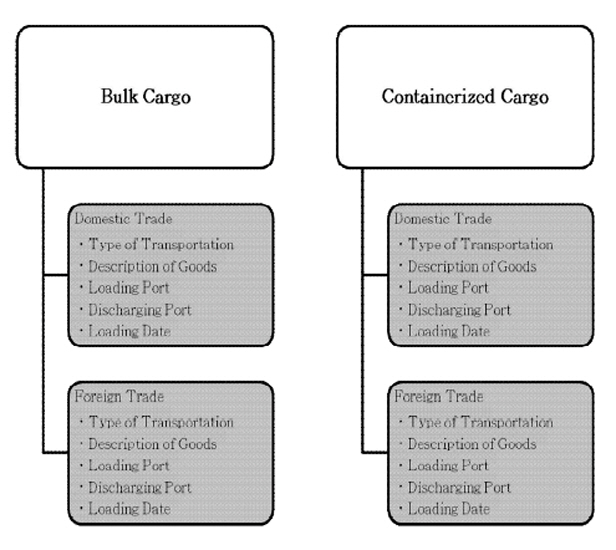
5.2 Cargo inquiry subsystem
We divided the frame of cargo inquiry subsystem into two parts, liner shipping service and charter party service. In the frame of cargo inquiry subsystem, shipping schedule becomes the most concern. Consignees eager to know the information of the ship, such as ship′s location, loading port, discharging port and the details of the vessel. So we suggested that the owner of e-commerce shipping platform can added many items that the consignees may interested and concerned. we give some example in Fig.
3, the owners can add more items as they want.
Fig. 3
The frame of cargo inquiry subsystem

5.3 On-line operating subsystem
As we investigated before, consignees are concerned about the e-commerce platform function of on-line booking 77.62% people choose this function. We suggested in the frame of on-line operating subsystem is the most important function of the e-commerce platform. The more on-line item the owner of the platform can provide, the more clients it will attract. We suggested the owner can establish the on-line operating subsystem into five parts, on-line inquiry, on-line document printing, on-line booking, on line customs declaration and on-line insurance. We give some examples in Fig.
4.
Fig. 4
The frame of on-line operating subsystem
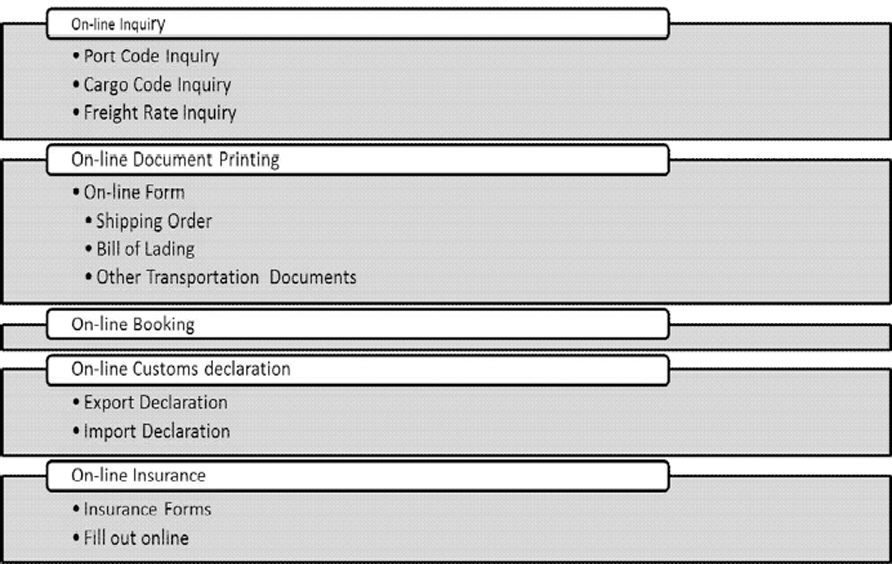
5.4 On-line Payment subsystem
Payment security is the core issue of electronic commerce. To guarantee the safety of electronic payment is not only a technical problem, but also a legal issue. To ensure the normal development of e-commerce, it is necessary to guarantee the safety of trade information and payment information. The encrypting technology and digital signature are important components of security technology of electronic commerce.
As shown in Fig.
5, we suggested the owner of the e-commerce shipping platform establishes the subsystem of on-line payment. The most important thing to the owner of the platform is to build a strong electronic payment gateway, to ensure customer payment security. Learning experience from DHL, by taking advantage of E-invoicing & E-billing solutions customers can make a fully digital information exchange with their customers anywhere in the world.
Fig. 5
The frame of on-line payment subsystem
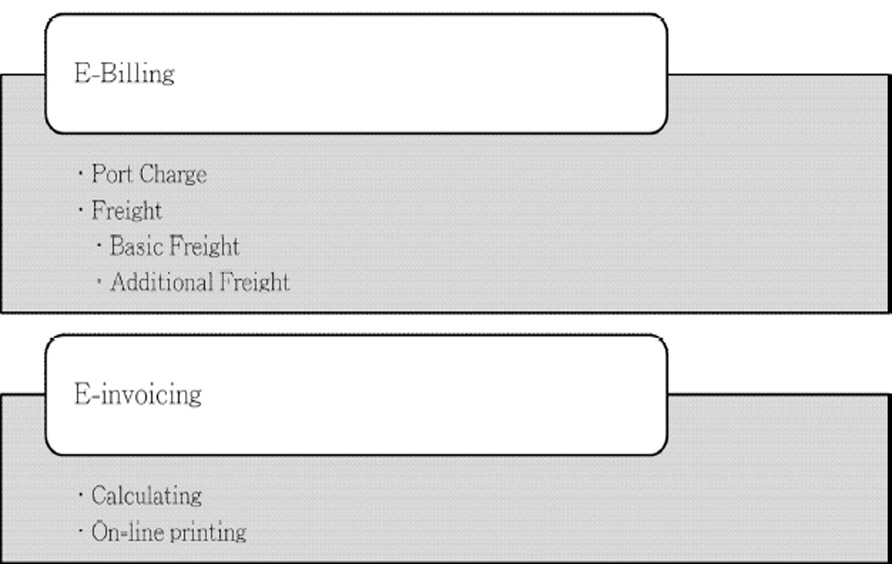
5.5 Customer relationship management subsystem
Customer relationship management is a constantly strengthen communication with customers, continuously to meet customer needs, to improve the products and services, and continuously improve to meet customer demand. The enterprise use information technology and internet technology to realize the integrated marketing to customers. Customer relationship management approach focuses on communication with customers. It can provide customers with a variety of communication channels. As shown in Fig.
6, We give some examples, the owners can add more items as they need.
Fig. 6
The frame of customer relationship management subsystem
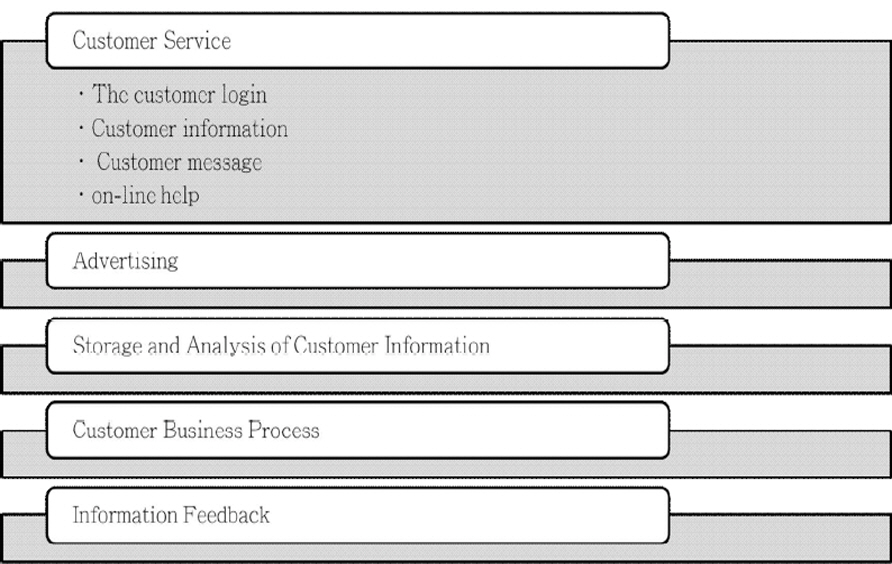
5.6 Database service subsystem
Now in the big data era, with the development of network technology, database technology and mobile computing technology, e-commerce model is widely used in the enterprise gradually. Database technology is widely used in the electronic commerce system, the development of e-commerce also plays a big role on database technology. As shown in Fig.
7, we suggested the owner of the e-commerce shipping platform to add items as we listed or the more items they wanted.
Fig. 7
The frame of database service subsystem
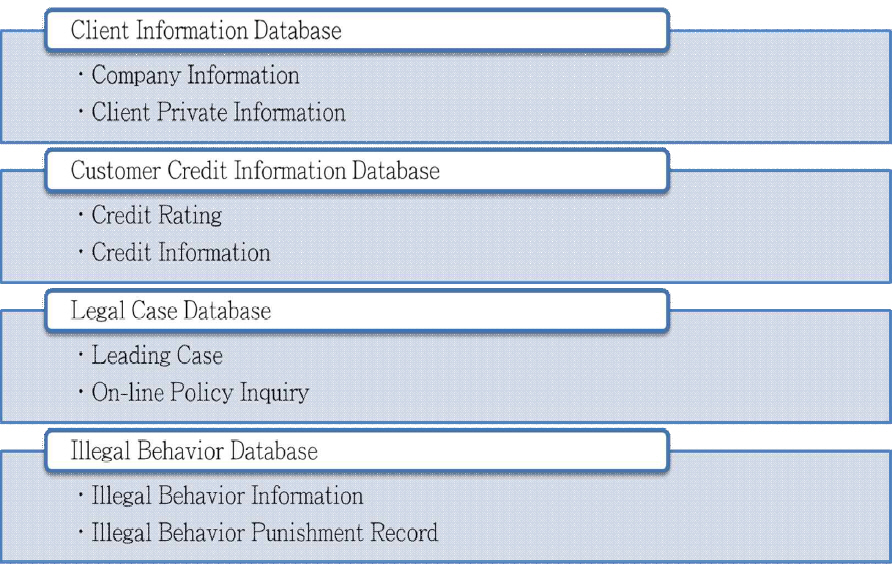
Conclusion
Based on the existing e-commerce shipping platforms, the situation of shipping industry in China, the main functions of establishing a shipping platform and how to choose an appropriate shipping platform are researched and analyzed in this paper.
There still are some limitations of the research, the data of questionnaire only comes from the internet while it is not investigated by the director of main department of shipping companies or logistics companies. It could be researched more in the future to apply to their opinions and suggestions.
For the past ten years, shipping e-commerce has been developed, but till now no one has succeeded in deed. At present, the e-commerce shipping platform is given priority to information exchange and actual transaction is subsidiary. Customers tend to know the latest booking and price information online and back to the familiar offline channels to transaction. In view of this situation, the O2O mode will become the mainstream of the shipping e-commerce business model.
The operator of the e-commerce shipping platform must establish more and more online functions, complete credit data and credit evaluation system. Vertical e-commerce shipping platforms and public service e-commerce shipping platforms shall clear their respective functions. Vertical e-commerce shipping platforms should focus on the supplement of customer service. Public service-commerce shipping platforms should committed to attract more and more consignees. As we suggested in Part 5, an integrated e-commerce platform is suitable for the future.
The trend of e-commerce shipping market is brilliant and prosperous.










 PDF Links
PDF Links PubReader
PubReader Full text via DOI
Full text via DOI Download Citation
Download Citation Print
Print






